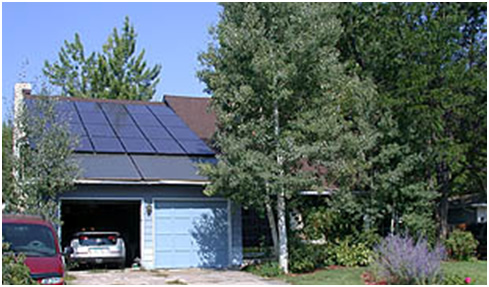Affirmation comes in many forms.
Around 30 like-minded people visited our place on Saturday to ask questions about the recent changes we’ve made to retrofit this 1974 home for more sustainable living. Of the 14 homes on the 2012 Colorado Renewable Energy Society’s (CRES) Sustainable Living tour, this year ours turned out to be the only one demonstrating the use of a geoexchange/geothermal heat pump for heating and cooling.
The CRES publicity for the tour (additional details are on the CRES website…) included one of my comments extracted from the pre-tour interview:
“Our transition to solar power began as a personal experiment to simply explore ways to live more sustainably but resulted in a comprehensive switch from fossil energy to renewable energy for all our household needs.”
The Sustainable Living tour ran from 9 am to 4pm. Our first visitor didn’t arrive until around 10 am, but shortly thereafter we had a steady flow of curious people asking great questions about our experiences with solar photovoltaic (PV) modules for the generation of electrical power, geoexchange/geothermal heat pumps for heating & cooling, and our plug-in hybrid car (Chevy Volt) for transportation.
Fortunately CRES provided several volunteers to help respond to this stream of inquisitive visitors. Without the help of these volunteers the open house experience would have been overwhelming for a host and not as helpful for the visitors. In our case, one of the CRES volunteers greeted people at the door and provided a brief overview of the three key features of our home. Another volunteer from a company that installs solar systems, REC Solar, focused on answering questions related to solar systems, so then I was able to concentrate on questions people had about the geoexchange heat pump that replaced our natural gas furnace a year ago. I was also able to field questions about our plug-in hybrid vehicle parked conspicuously in the driveway for everyone to see as they entered the house.
As one of this year’s 14 hosts, I personally found the day to be quite encouraging, albeit a bit tiring for an avid introvert who by nature has to expend energy meeting and greeting other people. The tour provided an opportunity to convey our experiences to others and describe how easy it was for us to transition our home from fossil fuel to renewable solar energy. People seemed to be surprised that the changes we made to our home took place in just a matter of three months. The solar system was installed in June (within approx. 2 work days) and the geoexchange heat pump was installed in August of 2011 (within approx 3 work days). Within that relatively short time frame we were able to transition from burning fossil energy to solar energy.
The most common question our visitors asked was of course, “How much did these changes cost? ” We explained the whole renewable energy makeover required an investment of about 11-12% of the value of the home and provide more detail in a handout available to each visitor. (See Sustainable Living Handout – Hetrick Home). As a result of this investment, the utilities for this home are now “pre-paid” for the next 20-25 years independent of how the price of coal, oil or natural gas eventually escalates. Better still, whoever lives in this home for the next quarter century, does so knowing that they are not contributing to the many issues associated with burning fossil fuel ( e.g. mountain top removal, fracking, addition of green house gases such as CO2 and methane or mercury and coal ash into the atmosphere, to name just a few).
Another common question was related to the concept of Return on Investment (ROI), “How many years does it take to break even?” According to the solar system installer’s calculation and assumption that the cost of electrical power historically increases at about 6% per year, the payback period for the Solar PV was calculated to be around 8-10 years – after that the power it produces is basically free. The payback period for the geoexchange heat pump is a bit more uncertain because it is not clear how the price of natural gas will increase over time, but a payback of 10-12 years seems reasonable.
As far as the plug-in hybrid is concerned, if we had continued to drive our van @ 20 mpg for 100,000 miles, we would have spent $25,000 on gasoline (assuming an average price per gallon of $5/ gallon over the next 10 years). If we drive that same 100,000 miles on gasoline with the new car @ 40 mpg, we save $12,500 in gasoline. If we drive 50,000 miles on gasoline and 50,000 miles on electric (free), we would be saving $18,750 from our previous life style.
Special thanks to Sam Johnson from REC Solar who handled all the Solar PV questions and to CRES Volunteers, Kevin Chenoweth and John Steele who met people at the door, provided a general overview of what they were about to see, and provided copies of our “Handout” explaining in detail the specific features and cost of the solar PV system and the geothermal heat pump.
Meeting 30 more people who want to learn more about Sustainable Living and how to stop burning hydrocarbons as their source of energy was indeed affirming.


so informative and inspiring: sorry I missed it!